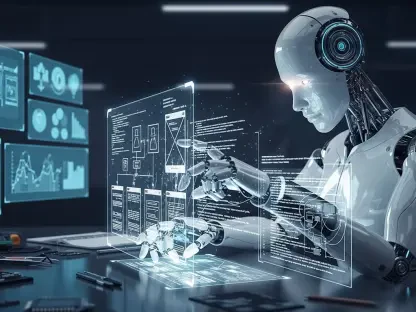Imagine a software development team where every member is hyper-specialized, tirelessly focused, and unburdened by past mistakes—resetting their perspective daily to tackle challenges anew. This isn’t a futuristic fantasy but a reality shaped by AI collaborative agents, a groundbreaking approach reshaping how technology integrates into agile workflows. These agents, functioning as a cohesive team of task-oriented entities, are redefining efficiency in software engineering by mirroring human team dynamics while eliminating common pitfalls like error accumulation. This review delves into the mechanisms, innovations, and real-world impact of this technology, offering a comprehensive look at its current state and transformative potential.
Core Features and Mechanisms
Specialization and Task Allocation
At the heart of AI collaborative agents lies the principle of specialization, where each agent is assigned a distinct role such as code generation, debugging, or performance optimization. Much like a human development team, this division ensures that every component of a project receives dedicated attention, minimizing overlap and enhancing precision. The clarity in roles not only streamlines complex workflows but also significantly boosts the quality of outputs by reducing redundant efforts.
This structured approach allows for a seamless breakdown of intricate tasks into manageable segments. By focusing on specific functions, these agents emulate the expertise of seasoned professionals while operating at a scale and speed unattainable by human teams. The result is a marked improvement in project turnaround times, particularly in environments demanding high precision and rapid iteration.
Daily Amnesia for Agile Progress
A standout feature of this technology is the “daily amnesia” mechanism, which resets the agents’ contextual memory on a regular basis. This intentional forgetfulness prevents the buildup of errors or biased outputs that often plague long-running AI systems, ensuring that each cycle begins with a fresh perspective. Aligned with agile methodologies, this reset fosters iterative progress in concise, focused bursts, mirroring the sprints common in modern software development.
The implications of this feature extend beyond mere error prevention. By discarding outdated or irrelevant data daily, the system maintains a high level of adaptability, crucial for projects where requirements evolve rapidly. This mechanism proves especially valuable in maintaining the reliability of outputs over extended periods, addressing a critical challenge in AI deployment.
Innovations Driving Collaboration
Structured Teamwork and Verification
Recent advancements in AI collaboration have introduced sophisticated methods for structured teamwork, leveraging APIs and shared prompts to enable cross-verification among agents. This interconnected framework allows for continuous refinement of outputs as agents validate each other’s work, reducing inaccuracies. Such integration marks a significant shift from isolated AI tools to a cohesive, interactive system capable of tackling multifaceted challenges.
Another notable trend is the embrace of probabilistic collaboration, where AI is viewed as a partner with inherent imperfections rather than a flawless solution. This mindset encourages engineers to iterate on initial results, refining them through feedback loops. The focus on collaboration over perfection has spurred adoption across various tech sectors, highlighting the practical value of this approach.
Industry Shifts and Iterative Mindsets
The tech industry has witnessed a behavioral shift among engineers, who increasingly adopt iterative processes to harness AI’s potential. Rather than expecting immediate, polished results, professionals now treat AI outputs as starting points for further development. This pragmatic perspective aligns with the dynamic nature of software engineering, where adaptability often trumps initial accuracy.
This evolving attitude is evident in how teams integrate AI into their workflows, prioritizing continuous improvement over static solutions. The emphasis on iteration not only mitigates the technology’s limitations but also fosters a culture of experimentation, driving innovation in application design and deployment strategies. As a result, AI collaborative agents are becoming indispensable in fast-paced development environments.
Real-World Impact and Applications
Enterprise Deployments in Content Management
In enterprise settings, AI collaborative agents have demonstrated remarkable efficacy, particularly in content management for e-commerce giants. Companies leveraging composable content platforms have utilized these agents to handle high-volume tasks, ensuring consistency and quality in dynamic digital environments. The ability to automate complex workflows while syncing real-time data through APIs has proven transformative for businesses requiring scalability.
Beyond e-commerce, industries like software development have adopted this technology to streamline coding and debugging processes. Platforms supporting all-code backends facilitate seamless integration, allowing teams to focus on innovation rather than repetitive tasks. These deployments underscore the versatility of AI agents in addressing diverse operational needs.
Community Contributions and Unique Use Cases
The adaptability of AI collaborative agents is further enhanced by community-driven enhancements, often shared through open-source platforms. Developers contribute to refining integrations, tailoring solutions to specific industry challenges, and expanding the technology’s reach. This collaborative spirit amplifies the impact of AI agents, fostering a collective push toward broader applicability.
Unique use cases also highlight the technology’s potential, such as automating data-heavy applications with precision. From managing intricate datasets to supporting real-time analytics, these agents offer tailored solutions that traditional tools struggle to match. Their role in niche areas continues to grow, signaling a widening scope of influence across sectors.
Challenges and Current Limitations
Technical Hurdles and Output Quality
Despite their promise, AI collaborative agents face significant technical challenges, including hallucinations and inconsistent outputs. Initial results are often subpar, requiring substantial iteration to achieve usable outcomes. This gap between expectation and reality poses a hurdle in environments where precision is non-negotiable, necessitating robust oversight mechanisms.
The issue of output quality is compounded by the complexity of training agents to handle nuanced tasks. Without careful calibration, the risk of errors persists, undermining trust in automated systems. Addressing these flaws remains a priority for developers aiming to elevate the technology’s reliability in critical applications.
Operational and Cultural Barriers
Operationally, the adoption of AI collaborative agents demands a mindset shift among engineers, who must view AI as a partner in an iterative journey rather than a definitive answer. Resistance to this perspective can slow integration, as teams grapple with balancing human oversight and automated processes. Cultural adaptation is thus as crucial as technical refinement in realizing the technology’s full potential.
Additionally, market dynamics play a role, with organizations hesitant to invest in systems perceived as experimental. Overcoming skepticism requires demonstrating tangible benefits through pilot projects and case studies. As understanding deepens, the barriers to widespread adoption are likely to diminish, paving the way for broader acceptance.
Looking Ahead: Future Potential
Redefining Development Practices
The trajectory of AI collaborative agents suggests a profound impact on software development, particularly through their integration into agile workflows. Over the coming years, from now until 2027, deeper alignment with iterative practices is expected, potentially redefining how teams approach problem-solving. The focus on focused, forgetful teamwork could become a cornerstone of efficient project management.
Anticipated breakthroughs include enhanced tools for role definition and feedback integration, further streamlining collaboration. As these advancements unfold, industries beyond tech may also adopt the model, applying it to areas like logistics or creative design. The ripple effect of such adoption promises to reshape productivity standards on a global scale.
Societal and Technological Implications
Long-term, the societal implications of AI collaborative agents are vast, positioning them as integral to adaptable work environments. Their ability to evolve alongside human teams could foster a new era of innovation, where technology and creativity intersect seamlessly. This synergy holds the potential to address complex global challenges with unprecedented agility.
On a technological level, the continued refinement of these agents may lead to smarter, more intuitive systems capable of anticipating user needs. As collaboration mechanisms mature, the boundary between human and AI contributions could blur, creating hybrid workflows that maximize efficiency. This vision, while ambitious, reflects the direction in which current trends are heading.
Final Reflections
Looking back, the exploration of AI collaborative agents revealed a technology that, despite early stumbles, carved a significant niche in software engineering through structured teamwork and intentional resets. The journey underscored both the hurdles of inconsistent outputs and the triumphs of iterative refinement. For those navigating this space, the next steps involve embracing tools like custom scripts for role clarity and leveraging robust platforms for data handling. Moving forward, fostering a culture of experimentation and patience with AI’s imperfections stands as a critical action, ensuring that teams can transform initial setbacks into stepping stones for innovation.









